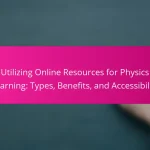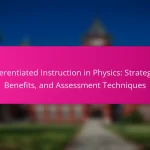Relativity is a fundamental theory in physics, primarily formulated by Albert Einstein, consisting of two key components: special relativity and general relativity. Special relativity, established in 1905, focuses on the behavior of objects moving at constant speeds, particularly near the speed of light, introducing concepts like time dilation and length contraction. General relativity, published in 1915, expands on these ideas by describing gravity as the curvature of spacetime caused by mass. The implications of relativity extend into various fields, influencing advancements in technology such as GPS and nuclear energy, while also enhancing our understanding of astrophysical phenomena like black holes and the expansion of the universe.
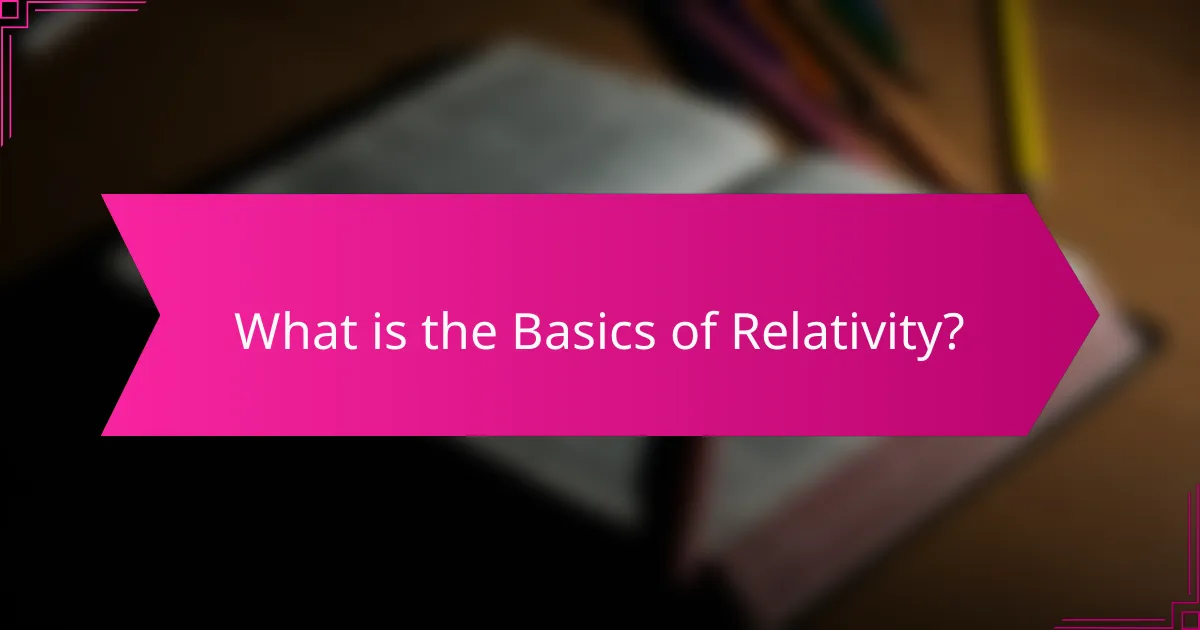
What is the Basics of Relativity?
Relativity is a fundamental theory in physics formulated by Albert Einstein. It encompasses two main theories: special relativity and general relativity. Special relativity, introduced in 1905, addresses the physics of objects moving at constant speeds, particularly at speeds close to the speed of light. It introduces concepts such as time dilation and length contraction, demonstrating that time and space are interconnected. General relativity, published in 1915, expands this framework to include acceleration and gravity. It describes gravity not as a force but as a curvature of spacetime caused by mass. Both theories have been confirmed through numerous experiments and observations, such as the bending of light around massive objects, observed during solar eclipses.
How did the concept of relativity emerge?
The concept of relativity emerged through Albert Einstein’s groundbreaking theories in the early 20th century. In 1905, Einstein published the Special Theory of Relativity. This theory introduced the idea that time and space are interconnected and relative to the observer’s motion. In 1915, he expanded this concept with the General Theory of Relativity. This theory described gravity as the curvature of spacetime caused by mass. The emergence of relativity was influenced by earlier work from physicists like Hendrik Lorentz and Henri Poincaré. Their contributions laid the groundwork for Einstein’s revolutionary ideas. The theories challenged classical mechanics and provided new insights into the nature of the universe.
What historical events led to the development of relativity?
The development of relativity was influenced by several key historical events. The publication of Isaac Newton’s “Philosophiæ Naturalis Principia Mathematica” in 1687 established classical mechanics. This laid the groundwork for understanding motion and gravity. In the late 19th century, experiments such as the Michelson-Morley experiment in 1887 sought to detect the existence of the luminiferous ether. The negative results of this experiment challenged existing theories of light propagation.
Additionally, the work of James Clerk Maxwell on electromagnetic theory in the 1860s unified electricity and magnetism. It revealed that light is an electromagnetic wave. Albert Einstein published his Special Theory of Relativity in 1905. This theory addressed the inconsistencies between Newtonian mechanics and Maxwell’s equations. In 1915, Einstein expanded this with the General Theory of Relativity, which provided a new understanding of gravity.
These events collectively shaped the scientific landscape, leading to the formulation of relativity.
Who were the key figures in the formulation of relativity?
The key figures in the formulation of relativity are Albert Einstein and Hendrik Lorentz. Albert Einstein developed the theories of special and general relativity. His 1905 paper introduced the concept of time dilation and mass-energy equivalence. Hendrik Lorentz contributed to the mathematical framework that described the behavior of objects moving at high speeds. His Lorentz transformations were essential for Einstein’s formulation. Other notable figures include Hermann Minkowski, who geometrically interpreted relativity, and David Hilbert, who worked on the mathematical aspects of general relativity.
What are the fundamental principles of relativity?
The fundamental principles of relativity are the theories proposed by Albert Einstein. The first principle is the constancy of the speed of light. According to Einstein’s special relativity, light travels at a constant speed of approximately 299,792 kilometers per second in a vacuum.
The second principle is the equivalence of inertial frames. This means that the laws of physics are the same for all observers in uniform motion.
The third principle involves the concept of spacetime. In general relativity, spacetime combines the three dimensions of space with the dimension of time into a single four-dimensional continuum.
These principles fundamentally changed our understanding of time, space, and gravity. They have been validated through numerous experiments and observations, such as the bending of light around massive objects.
What is the difference between special and general relativity?
Special relativity addresses the physics of objects moving at constant speeds, particularly at speeds close to the speed of light. It introduces concepts such as time dilation and length contraction, which occur due to the relative motion between observers. General relativity, on the other hand, extends these principles to include acceleration and gravity. It describes gravity not as a force, but as the curvature of spacetime caused by mass. The mathematical framework of general relativity is more complex, incorporating differential geometry. Special relativity applies to inertial frames of reference, while general relativity applies to non-inertial frames. This distinction highlights the broader applicability of general relativity in explaining gravitational phenomena.
How do time and space interact in relativity?
Time and space interact in relativity through the concept of spacetime. In relativity, time is not an absolute entity; it is relative and depends on the observer’s frame of reference. Space and time are intertwined, forming a four-dimensional continuum known as spacetime. The theory posits that the presence of mass and energy can curve spacetime. This curvature affects the motion of objects and the passage of time. For example, a clock in a strong gravitational field ticks slower than one in a weaker field. This phenomenon is known as time dilation. Experimental evidence, such as the Hafele-Keating experiment, confirms that time is affected by relative motion and gravity. Thus, time and space are fundamentally linked in the framework of relativity.
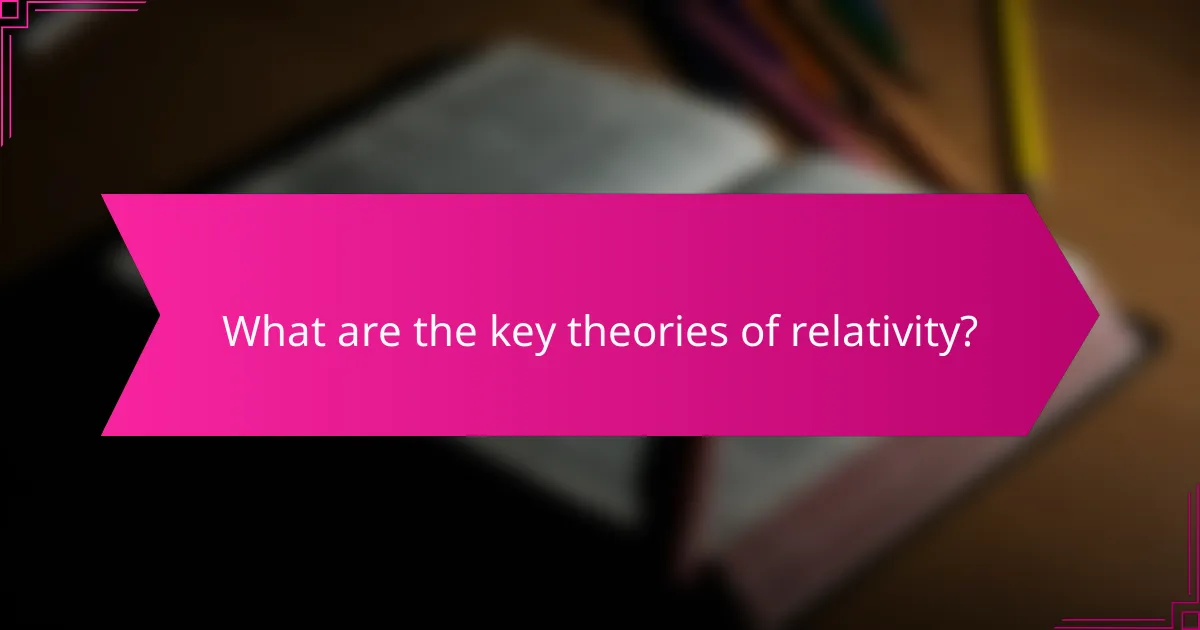
What are the key theories of relativity?
The key theories of relativity are the Special Theory of Relativity and the General Theory of Relativity. The Special Theory of Relativity, proposed by Albert Einstein in 1905, addresses the physics of objects moving at constant speeds, particularly at speeds close to the speed of light. It introduces concepts such as time dilation and length contraction. The General Theory of Relativity, introduced in 1915, expands on these ideas by incorporating gravity as a curvature of spacetime. It describes how massive objects influence the motion of other objects and the flow of time. Both theories have been validated through numerous experiments, such as the observation of light bending around massive objects during solar eclipses.
What is Einstein’s theory of special relativity?
Einstein’s theory of special relativity is a fundamental theory in physics that describes the relationship between space and time. It asserts that the laws of physics are the same for all observers, regardless of their relative motion. This theory introduces the concept that the speed of light in a vacuum is constant and independent of the motion of the light source. Special relativity leads to several counterintuitive implications, such as time dilation and length contraction. These effects occur at speeds approaching the speed of light. The theory was first published in 1905 in Einstein’s paper “On the Electrodynamics of Moving Bodies.” Special relativity has been confirmed through numerous experiments, such as those involving particle accelerators and atomic clocks.
What are the core postulates of special relativity?
The core postulates of special relativity are two fundamental principles. The first postulate states that the laws of physics are the same for all observers in uniform motion relative to one another. This means that no matter the observer’s speed, the laws of physics apply equally. The second postulate asserts that the speed of light in a vacuum is constant and independent of the motion of the light source. This implies that all observers, regardless of their relative motion, will measure the same speed of light. These postulates were first introduced by Albert Einstein in 1905. They revolutionized the understanding of time and space, leading to significant advancements in physics.
How does special relativity alter our understanding of time and space?
Special relativity fundamentally changes our understanding of time and space by introducing the concept that they are interwoven into a single continuum known as spacetime. According to Einstein’s theory, the passage of time is not absolute; it varies for observers in different states of motion. For example, time dilation occurs when an object moves close to the speed of light. Observers in motion will measure time passing more slowly compared to those at rest.
Additionally, the theory asserts that space is not a fixed backdrop. Distances can contract depending on the relative velocity between observers. This means that two observers moving relative to one another may measure different lengths for the same object.
The implications of special relativity have been confirmed through numerous experiments, such as those involving atomic clocks on fast-moving jets. These clocks show measurable time differences compared to stationary clocks, validating the theory’s predictions. Thus, special relativity reshapes our understanding by revealing that time and space are relative, depending on the observer’s motion.
What is Einstein’s theory of general relativity?
Einstein’s theory of general relativity is a fundamental theory of gravitation. It describes gravity not as a force, but as a curvature of spacetime caused by mass. Massive objects like planets and stars warp the fabric of spacetime around them. This warping affects the motion of other objects, causing them to follow curved paths. General relativity predicts phenomena such as the bending of light around massive objects. It has been confirmed through various experiments, including the observation of light bending during solar eclipses. This theory revolutionized our understanding of gravity and the universe.
How does general relativity explain gravity?
General relativity explains gravity as the curvature of spacetime caused by mass. According to Einstein’s theory, massive objects like planets and stars warp the fabric of spacetime around them. This curvature affects the motion of other objects, causing them to follow curved paths. For instance, Earth orbits the Sun due to this spacetime curvature. The theory predicts that light also bends around massive objects, a phenomenon confirmed during the 1919 solar eclipse. This bending of light further validates general relativity’s explanation of gravity. Thus, gravity is not a force but the result of objects moving along curved paths in a warped spacetime.
What are the implications of general relativity on cosmology?
General relativity fundamentally reshapes cosmology by providing a framework for understanding the universe’s structure and evolution. It describes how mass and energy influence the curvature of spacetime. This curvature dictates the motion of celestial bodies and the dynamics of the universe.
The theory predicts phenomena such as the expansion of the universe, which was confirmed by Edwin Hubble’s observations of redshift in distant galaxies. General relativity also leads to the concept of black holes, regions of spacetime with gravitational pulls so strong that nothing can escape.
Furthermore, it supports the Big Bang theory, explaining the universe’s origin from a singularity. The theory’s equations describe how the universe can expand or contract over time. Observations of cosmic microwave background radiation provide evidence for these predictions.
Overall, general relativity is essential for modern cosmology, influencing our understanding of cosmic events and structures.
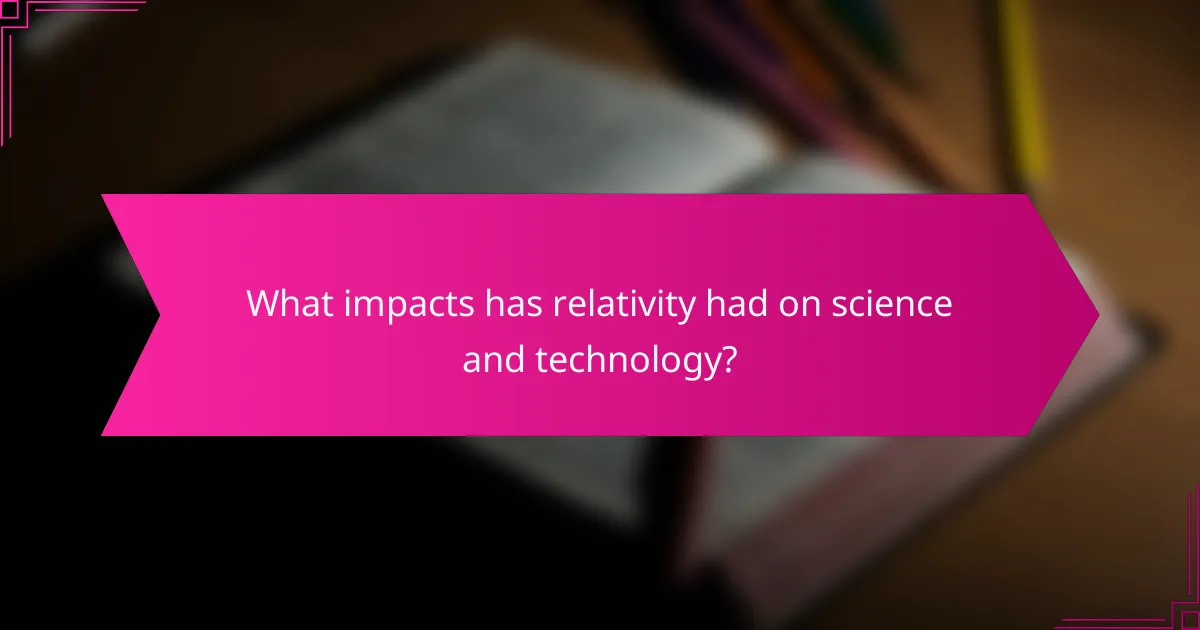
What impacts has relativity had on science and technology?
Relativity has profoundly impacted science and technology by reshaping our understanding of space, time, and gravity. Einstein’s theories led to advancements in GPS technology, which relies on precise time measurements affected by relativistic effects. The Global Positioning System accounts for time dilation due to satellites moving at high speeds and being in different gravitational fields. Additionally, relativity has influenced the development of nuclear energy, as it explains the energy-mass equivalence principle, encapsulated in E=mc². This principle underlies nuclear fission and fusion processes. Furthermore, relativity has enhanced the field of astrophysics, providing insights into phenomena such as black holes and the expansion of the universe. Observations of gravitational waves, confirmed in 2015, validate predictions made by general relativity. Thus, relativity has been essential in advancing both theoretical and applied sciences.
How has relativity influenced modern physics?
Relativity has profoundly influenced modern physics by reshaping our understanding of space, time, and gravity. Albert Einstein’s theories of Special and General Relativity introduced concepts that challenged classical mechanics. Special Relativity established that the laws of physics are the same for all observers, regardless of their relative motion. This theory also introduced the idea that the speed of light is constant in a vacuum, leading to the famous equation E=mc². General Relativity further expanded this understanding by describing gravity as the curvature of spacetime caused by mass. This theory has been confirmed through numerous experiments, such as the observation of light bending around massive objects during solar eclipses. Relativity has also paved the way for advancements in technology, such as GPS systems, which require adjustments based on relativistic effects. Overall, relativity has fundamentally altered our comprehension of the universe and continues to underpin modern theoretical physics.
What are some practical applications of relativity in technology?
Relativity has practical applications in technology, particularly in GPS systems. GPS satellites rely on precise timing signals. These signals must account for time dilation effects predicted by relativity. Due to their speed and altitude, time on satellites runs slightly faster than on Earth. Without adjusting for this difference, GPS calculations would be inaccurate. The adjustment ensures location accuracy within meters. Additionally, relativity is crucial in particle accelerators. These facilities, like the Large Hadron Collider, use relativistic principles to accelerate particles close to the speed of light. This enables the study of fundamental particles and forces.
How has relativity changed our understanding of the universe?
Relativity has fundamentally transformed our understanding of the universe by altering concepts of space, time, and gravity. It introduced the idea that time is not a constant but can vary depending on speed and gravity. This was demonstrated through the theory of time dilation, which shows that time moves slower for objects moving at high velocities.
Einstein’s general relativity redefined gravity as the curvature of spacetime caused by mass. This explained phenomena such as the bending of light around massive objects, confirmed during the solar eclipse of 1919. The theory also predicted the existence of black holes and gravitational waves, which have been observed and confirmed by modern astrophysics.
Relativity has led to advancements in technologies like GPS, which must account for relativistic effects to provide accurate location data. Overall, relativity has reshaped our understanding of the cosmos, from the behavior of light to the structure of the universe itself.
What thought experiments illustrate the principles of relativity?
The thought experiments that illustrate the principles of relativity include the train and lightning scenario, the twin paradox, and Einstein’s elevator. The train and lightning thought experiment demonstrates how observers in different frames of reference perceive simultaneous events differently. In this scenario, a train moving at high speed strikes a lightning bolt at both ends. Observers on the train and those on the ground perceive the timing of the lightning strikes differently, illustrating time dilation.
The twin paradox involves one twin traveling at relativistic speeds while the other remains on Earth. When the traveling twin returns, they are younger than their Earth-bound sibling. This illustrates the effects of time dilation as described by special relativity.
Einstein’s elevator thought experiment visualizes the principle of equivalence. It posits that an observer inside a closed, accelerating elevator cannot distinguish between acceleration and gravity. This illustrates how gravity affects time and space, foundational concepts in general relativity. Each of these thought experiments provides critical insights into the counterintuitive nature of relativistic physics.
What is the significance of the twin paradox?
The twin paradox illustrates the effects of time dilation in special relativity. In this thought experiment, one twin travels at a high speed into space while the other remains on Earth. Upon the traveling twin’s return, they are younger than their Earth-bound sibling. This outcome challenges our intuitive understanding of time as absolute. The significance lies in demonstrating that time is relative and depends on the observer’s velocity. Experimental evidence, such as atomic clock experiments on fast-moving jets, supports this phenomenon. These experiments show measurable time differences consistent with predictions from Einstein’s theory of relativity.
How does the thought experiment of light clocks demonstrate relativity?
The thought experiment of light clocks demonstrates relativity by illustrating how time is perceived differently by observers in relative motion. A light clock consists of two mirrors between which a beam of light bounces. For an observer at rest with the clock, the light travels directly up and down between the mirrors. This path defines a specific time interval.
However, for an observer moving relative to the clock, the light beam appears to take a longer, diagonal path. This results in the moving observer measuring a longer time interval for the same event. This effect is a direct consequence of the principles of special relativity, particularly time dilation.
Einstein’s theory posits that the speed of light is constant for all observers. Hence, as the moving observer perceives the light traveling a longer distance, they also observe time to be passing more slowly compared to their stationary counterpart. This thought experiment effectively illustrates how motion affects the measurement of time, thereby demonstrating the core tenet of relativity.
What are some common misconceptions about relativity?
Common misconceptions about relativity include the belief that it only applies to objects moving at high speeds. In reality, relativity applies universally, affecting all objects regardless of their speed. Another misconception is that time dilation means time actually slows down. Time dilation indicates that observers in different frames of reference measure time differently, not that time itself changes. Some people think that mass increases with speed, while, according to Einstein’s theory, it is the energy that increases, not mass itself. A frequent misunderstanding is that gravity is a force in relativity. Instead, gravity is described as the curvature of spacetime caused by mass. Lastly, many believe that relativity contradicts Newtonian physics. In fact, Newtonian physics is a special case of relativity, applicable at low speeds. These misconceptions can lead to confusion about the fundamental principles of Einstein’s theories.
Why do people misunderstand the concept of time dilation?
People misunderstand the concept of time dilation due to its counterintuitive nature. Time dilation occurs when an object moves at a significant fraction of the speed of light. According to Einstein’s theory of relativity, time appears to pass more slowly for the moving object compared to a stationary observer. This phenomenon is not observable at everyday speeds, making it difficult to grasp.
Additionally, the mathematical equations involved can be complex. The Lorentz transformation equations describe how time and space are interrelated. Many people lack familiarity with these equations, which can lead to misconceptions.
Misinterpretations often arise from popular media portrayals that simplify or exaggerate the concept. These portrayals can create a false understanding of how time behaves under relativistic conditions. Scientific education also tends to underemphasize these concepts, contributing to the confusion.
Overall, the combination of counterintuitive effects, complex mathematics, and inadequate educational emphasis leads to widespread misunderstanding of time dilation.
How does the relativity of simultaneity confuse many learners?
The relativity of simultaneity confuses many learners because it challenges their intuitive understanding of time. According to Einstein’s theory of relativity, simultaneity is not absolute. Events that appear simultaneous in one frame of reference may not be simultaneous in another. This contradicts everyday experiences where time is perceived as uniform. Learners often struggle to grasp how relative motion affects the timing of events. For example, if two lightning strikes occur simultaneously for one observer, they may not for another moving relative to the first. This concept is counterintuitive and requires a shift in thinking about time and space.
What are practical tips for studying relativity effectively?
To study relativity effectively, focus on understanding the core concepts first. Begin with the principles of special relativity, such as time dilation and length contraction. Use visual aids to grasp these abstract ideas. Diagrams can illustrate how time and space are interwoven. Engage with thought experiments, like Einstein’s train scenario, to deepen comprehension. Solve problems to apply theoretical knowledge practically. Regularly review key equations, such as the Lorentz transformation. Utilize online resources or textbooks for diverse explanations. Join study groups for discussion and clarification of complex topics. These strategies enhance retention and understanding of relativity.
The main entity of the article is relativity, specifically focusing on its key theories, impacts, and thought experiments. The article outlines the fundamental principles of special and general relativity, explaining how they revolutionized our understanding of time, space, and gravity. It discusses the historical context and key figures involved in the development of these theories, as well as their implications on modern science and technology. Additionally, the article addresses common misconceptions about relativity and provides practical tips for studying its concepts effectively.

